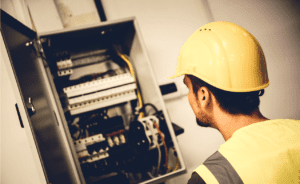Part 1 of the blog series: Navigating the 2020 National Electrical Code updates
Updates to the National Electrical Code (NEC) are out, and it’s time to get up to speed on the changes that impact you as a specifier in the U.S.
Every three years, the National Fire Protection Association (NFPA) collaborates with industry experts to update the NEC based on new standards in electrical safety and advances in electrical design and technology. These efforts reduce hazards such as shock, arc flash, and arc blast. In a nutshell, buildings and people are safer because of the NEC.
For 2020, some of the most significant updates involve service equipment such as panelboards, switchboards, switchgear, transfer switches, and enclosed switches. System designers, these will directly impact you, so pay close attention to the changes highlighted below.
What are the 4 NEC changes for service equipment?
- 230.62 (C) Line-side barriers
As of 2020, line-side barriers are required for all equipment carrying a “suitable only for use as service equipment” rating, including safety switches and transfer switches. This precaution is all about reducing exposure to electric shock.
As you may recall, prior versions of this code only required line-side barriers for panelboards, switchboards, and switchgear. This update simply expands on that list.
Line-side barriers are available in kits from electrical manufacturers and can be retrofitted into most service equipment.
- 230.67 Surge protection for dwellings
All services supplying dwellings now require surge protection installed either as part of the service equipment or located immediately adjacent to it. For buildings with multiple dwellings, such as commercial apartments or condominiums, you can install surge protection at each dwelling’s load center or panelboard instead of in the service equipment. This keeps the surge protection closer to the protected loads.
This code change doesn’t just apply to new equipment. If you’re repairing or replacing service equipment for damaged gear or service upgrades, you must now include whole-home surge protection.
- 230.71 Maximum number of disconnects
Before this update, you were allowed up to six service disconnects. The new code now states that each service should have only one readily accessible means of disconnection. However, there are exceptions to this code found under 230.71(B), which factor in the equipment type, construction, and installation configuration.
These include:
- When there are multiple service equipment enclosures, each can have one disconnect.
- Panelboards can have one disconnect per enclosure.
- Switchboards can have one disconnect per vertical section when there are barriers between each section.
- Compartmentalized switchgear and metering centers can have a disconnect in each separate compartment.
This change has a significant impact on the electrical system design and equipment selection. For example, the traditional practice of using a main-lug-only panelboard with up to six service disconnects is no longer permitted.
- 110.26 Large equipment working space
Another significant change for system designers and specifiers in the 2020 NEC pertains to large equipment over six feet long and rated 1,200 amps or more. These changes are important, not just because they enhance worker safety, but because they will also impact the layout of equipment in an electrical room.
When considering large equipment, the code requires the installation to have an entrance or egress at each end of the workspace. Additionally, open service equipment doors should not impede the entrance or egress to the area.
So, what’s changed? Installations with multiple service disconnects must use the total combined rating of the disconnects along with the overall equipment width to determine if this is considered large equipment. Using the ratings of each disconnect is straightforward.
However, there is a gray area when it comes to determining the equipment width. Let’s say you have three 400-amp switches on a wall. The combined amperage is 1200 amps, which meets one of the two criteria for large equipment. Next, you must measure the length of the equipment to determine whether it meets the code width minimum. But what if one of these switches is separated from the others due to the building structure, or it sits on the opposite wall? The code doesn’t specify how to handle measurements for equipment in multiple, separate enclosures.
What’s the best way to handle this? Confer with your local inspection authority before finalizing a design. You can also reach out to Schneider Electric’s on-demand electrical distribution application experts.
Ensuring electrical safety in an ever-evolving industry
These code updates are just a few of the many changes in the 2020 NEC that promote electrical safety.
In my next post in this series, I’ll discuss three additional NEC updates that directly impact contractors.
You can also check out my latest video on these changes: Innovation Talk: 2020 National Electrical Code Change Highlights.
Not registered for the mySchneiderPartner Portal? Sign up here to access this talk as well as additional trainings, technical guides, applications, and support.




Conversation
I’m having the electric service in my Los Angeles California residence (built in the 1940s) upgraded and was wondering if exterior front and rear outlets are required for an existing home or just new construction. Can you direct me to the Appropriate section of the NEC? Thank you.